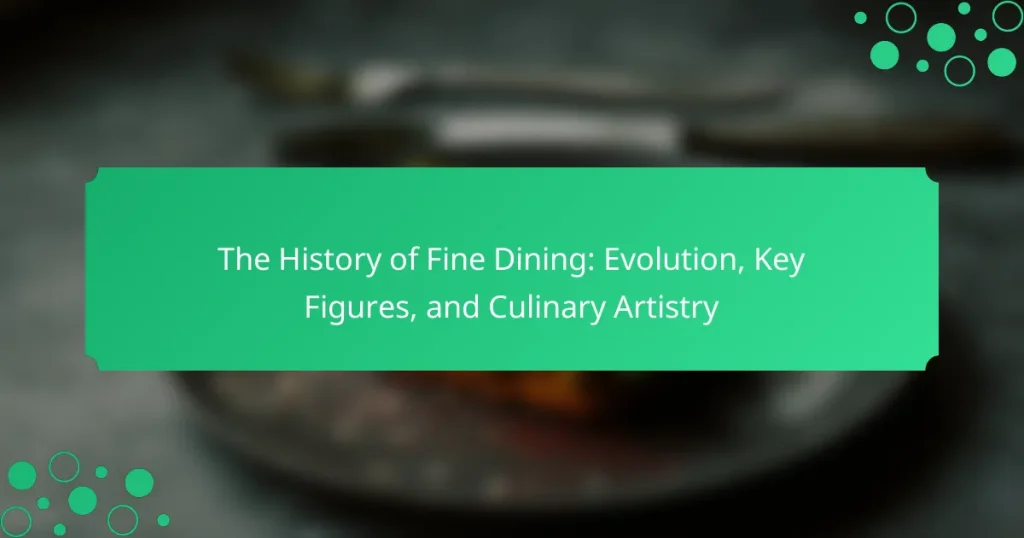Fine dining is a culinary practice that originated in the 18th century, evolving from exclusive royal banquets to accessible public restaurants. The French Revolution in 1789 marked a significant turning point, leading to the emergence of professional chefs who established restaurants. Key figures such as Auguste Escoffier played a crucial role in the late 19th century by systematizing culinary techniques and introducing the brigade system, which improved kitchen efficiency. The Michelin Guide, created in 1900, further elevated the standards of fine dining by rating restaurants. Following World War II, fine dining expanded globally, embracing diverse cuisines and emphasizing creativity, presentation, and high-quality ingredients, reflecting cultural shifts and a growing appreciation for culinary artistry.

What is the history of fine dining?
Fine dining has roots in the 18th century, evolving from royal banquets to public restaurants. The French Revolution in 1789 led to the rise of professional chefs opening restaurants. Auguste Escoffier, a key figure in the late 19th century, systematized culinary techniques and menus. He introduced the brigade system, enhancing kitchen efficiency. The Michelin Guide, established in 1900, rated restaurants, elevating fine dining standards. Post-World War II, fine dining expanded globally, incorporating diverse cuisines. Today, fine dining emphasizes creativity, presentation, and high-quality ingredients. This evolution reflects cultural shifts and the growing appreciation for culinary artistry.
How has fine dining evolved over the centuries?
Fine dining has evolved significantly over the centuries. Initially, it was a privilege of the elite in ancient civilizations. The Romans hosted elaborate feasts with multiple courses and exotic ingredients. In the Middle Ages, dining became more communal, with large tables and shared dishes. The Renaissance introduced a focus on presentation and refined techniques. By the 18th century, French cuisine began to dominate, emphasizing sauces and intricate preparations. The 19th century saw the rise of restaurants, making fine dining more accessible. In the 20th century, global influences began to shape culinary styles. Today, fine dining incorporates diverse cuisines, sustainability, and innovative techniques.
What were the key historical milestones in the development of fine dining?
The development of fine dining includes several key historical milestones. In the 18th century, the modern restaurant concept emerged in Paris. This period saw the rise of establishments serving elaborate meals to the public. In 1850, the introduction of the à la carte menu allowed diners to choose individual dishes. The late 19th century marked the establishment of haute cuisine, emphasizing technique and presentation. The Michelin Guide began in 1900, influencing dining standards and restaurant reputations. In the 1980s, nouvelle cuisine shifted focus to fresh ingredients and lighter dishes. The 21st century brought a rise in molecular gastronomy, blending science with culinary art. Each milestone contributed to the evolution of fine dining as we know it today.
What cultural influences have shaped fine dining practices?
Fine dining practices have been shaped by various cultural influences throughout history. French cuisine has significantly impacted fine dining, establishing techniques and presentation standards. The development of haute cuisine in the 19th century emphasized elaborate dishes and formal service. Italian culinary traditions introduced concepts of regional ingredients and seasonal menus. Asian cultures, particularly Chinese and Japanese, influenced presentation aesthetics and dining rituals. The rise of global cuisine has led to fusion dishes, blending diverse culinary traditions. Social status and wealth have historically dictated access to fine dining experiences. Additionally, cultural movements, such as the slow food movement, emphasize sustainability and local sourcing in fine dining.
Who are the key figures in the history of fine dining?
Auguste Escoffier is a key figure in the history of fine dining. He revolutionized French cuisine and established modern culinary practices. Escoffier introduced the brigade de cuisine system in professional kitchens. This system streamlined kitchen operations and improved efficiency. He authored “Le Guide Culinaire,” a foundational cookbook for chefs. Another important figure is Fernand Point, known for his influence on modern French cuisine. Point emphasized fresh ingredients and innovative techniques. His restaurant, La Pyramide, became a culinary landmark. Additionally, Alice Waters is notable for promoting farm-to-table dining. She founded Chez Panisse, which emphasized seasonal and local ingredients. These figures significantly shaped the evolution of fine dining.
What contributions did Auguste Escoffier make to fine dining?
Auguste Escoffier revolutionized fine dining by establishing modern French cuisine. He introduced the concept of the kitchen brigade system, which organized kitchen staff into specific roles. This structure improved efficiency and consistency in meal preparation. Escoffier also popularized the use of fresh ingredients and seasonal produce, enhancing the quality of dishes. He created classic recipes that are still foundational in culinary schools today. His book, “Le Guide Culinaire,” serves as a definitive reference for chefs. Escoffier emphasized the importance of presentation, elevating the visual appeal of dishes. His contributions laid the groundwork for contemporary fine dining practices.
How did influential chefs and restaurateurs change the culinary landscape?
Influential chefs and restaurateurs transformed the culinary landscape by redefining dining experiences and elevating cuisine. They introduced innovative techniques and ingredients, fostering a culture of creativity. Chefs like Auguste Escoffier established foundational culinary practices and standardized recipes. This standardization improved consistency and quality in restaurants. Restaurateurs created unique dining atmospheres, merging food with art and hospitality. For instance, Alice Waters popularized farm-to-table dining, emphasizing fresh, local ingredients. This movement influenced sustainable practices in the industry. Additionally, chefs like Ferran Adrià pioneered molecular gastronomy, challenging traditional cooking methods. Their contributions reshaped public perceptions of food and dining, making it a form of artistic expression.
What role does culinary artistry play in fine dining?
Culinary artistry is essential in fine dining as it elevates the dining experience through creativity and presentation. It transforms food into visually stunning dishes that engage multiple senses. The artistry involves intricate techniques, flavor pairing, and innovative cooking methods. Chefs often use seasonal and high-quality ingredients to enhance the dish’s appeal. This attention to detail creates a memorable experience for guests. Culinary artistry also reflects cultural influences and personal expression. According to a study by the Culinary Institute of America, presentation significantly impacts diners’ perceptions of taste. Fine dining relies on this artistry to differentiate itself from casual dining experiences.
How is culinary artistry defined within the context of fine dining?
Culinary artistry in fine dining is defined as the creative and skillful preparation of food that emphasizes aesthetics and flavor. It involves the use of high-quality ingredients and innovative cooking techniques. Chefs in fine dining establishments often create visually stunning dishes that are meticulously plated. The presentation of food is as important as its taste. Culinary artistry also includes the combination of flavors and textures to enhance the dining experience. Fine dining chefs often draw inspiration from various cultural cuisines. They may employ unique techniques such as sous-vide or molecular gastronomy. This artistry is essential for creating memorable dining experiences that engage all the senses.
What techniques and skills are essential for culinary artistry in fine dining?
Essential techniques and skills for culinary artistry in fine dining include precision cooking, flavor balancing, and plating aesthetics. Precision cooking involves using techniques like sous-vide and temperature control to achieve consistent results. Flavor balancing requires chefs to understand the interplay of ingredients, ensuring dishes are harmonious. Plating aesthetics focuses on the visual presentation of food, which is critical in fine dining. Knife skills are fundamental for preparation and presentation. Additionally, knowledge of various cuisines enhances creativity and adaptability. Mastery of these skills is supported by formal culinary education and extensive practice in high-pressure environments.
How does the history of fine dining connect to modern trends?
The history of fine dining connects to modern trends through its foundational principles of quality, presentation, and service. Fine dining originated in the 18th century with the establishment of haute cuisine in France. This culinary movement emphasized meticulous preparation and elegant presentation. Modern trends borrow from this tradition by focusing on artisanal ingredients and innovative plating techniques.
Additionally, the rise of farm-to-table concepts reflects the historical emphasis on fresh, local produce. Today’s fine dining establishments often prioritize sustainability, echoing the values of early chefs who sourced quality ingredients. The influence of global cuisines has also evolved from the historical exchanges in fine dining, leading to fusion dishes that blend diverse culinary traditions.
Furthermore, the dining experience has transformed into an event, akin to the elaborate meals of the past. This shift is evident in the use of multi-course tasting menus, which pay homage to the intricate dining experiences of history. Overall, modern fine dining continues to draw inspiration from its rich historical roots while adapting to contemporary tastes and values.
What are the defining characteristics of contemporary fine dining establishments?
Contemporary fine dining establishments are characterized by high-quality cuisine, exceptional service, and an elegant atmosphere. These restaurants often feature innovative menus that emphasize seasonal and locally sourced ingredients. Attention to detail is paramount in both food presentation and service. The dining experience is typically enhanced by a carefully curated wine list. Many contemporary fine dining venues also incorporate unique culinary techniques and artistic plating. The ambiance often includes sophisticated decor and a well-thought-out layout to enhance guest comfort. Reservations are commonly required, reflecting exclusivity and demand. Overall, contemporary fine dining aims to provide a memorable and immersive culinary experience.
How have consumer preferences influenced the evolution of fine dining menus?
Consumer preferences have significantly influenced the evolution of fine dining menus. As diners increasingly seek unique and personalized experiences, chefs adapt their offerings accordingly. Trends like farm-to-table and sustainable sourcing reflect consumer demand for fresh, local ingredients. Health-conscious eating has led to the inclusion of plant-based and gluten-free options on menus. Additionally, global culinary influences have expanded as consumers embrace diverse flavors and cuisines. The rise of social media has also shaped menu design, as visually appealing dishes attract attention online. These shifts demonstrate that the fine dining industry evolves in response to changing consumer tastes and values.
What practical tips can enhance the fine dining experience?
To enhance the fine dining experience, focus on several practical tips. First, dress appropriately for the restaurant’s ambiance. Many fine dining establishments have dress codes that elevate the experience. Second, arrive on time for your reservation. This respects the restaurant’s schedule and enhances your dining experience. Third, engage with the staff. Asking questions about the menu can lead to personalized recommendations. Fourth, consider wine pairings suggested by the sommelier. Proper pairings can elevate the flavors of your meal. Fifth, savor each course slowly. Fine dining is about enjoying the culinary artistry presented. Finally, express gratitude to the staff. Acknowledging their service enhances the overall atmosphere. These tips collectively contribute to a more enjoyable fine dining experience.
How can diners choose the best fine dining restaurant for their needs?
Diners can choose the best fine dining restaurant for their needs by assessing several key factors. First, they should consider the restaurant’s cuisine type. Different fine dining establishments specialize in various culinary traditions. Next, diners should evaluate the restaurant’s ambiance. The atmosphere can greatly impact the dining experience. Additionally, they should review the restaurant’s menu offerings. A diverse and well-curated menu can enhance enjoyment. It’s also important to check customer reviews and ratings. Feedback from previous diners provides insight into the quality of service and food. Lastly, diners should consider the restaurant’s location and accessibility. Proximity can influence convenience and overall satisfaction. These factors collectively help diners make informed choices about fine dining options.
What etiquette should be observed in fine dining settings?
Fine dining etiquette involves specific behaviors and practices. Guests should arrive on time to respect the host and restaurant staff. Place settings should be understood, with utensils used from the outside in. Napkins should be placed on laps upon sitting and used discreetly. Speaking softly is expected to maintain a pleasant atmosphere. Cell phones should be silenced or not used at the table. Tipping is customary, typically 15-20% of the bill. These practices enhance the dining experience and reflect respect for the establishment and fellow diners.
The main entity of the article is fine dining, which encompasses its historical evolution, key figures, and the role of culinary artistry. The article traces fine dining’s origins from royal banquets in the 18th century to the establishment of professional restaurants following the French Revolution. It highlights significant milestones, such as the introduction of the à la carte menu and the influence of chefs like Auguste Escoffier. Additionally, it explores how cultural influences and contemporary trends have shaped fine dining practices, emphasizing the importance of quality ingredients, presentation, and innovative techniques in creating memorable dining experiences.




